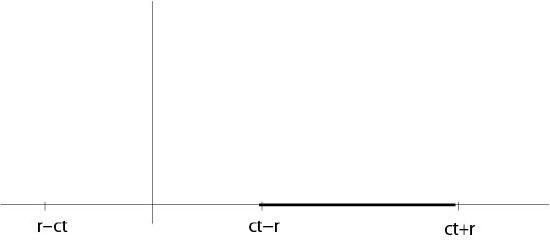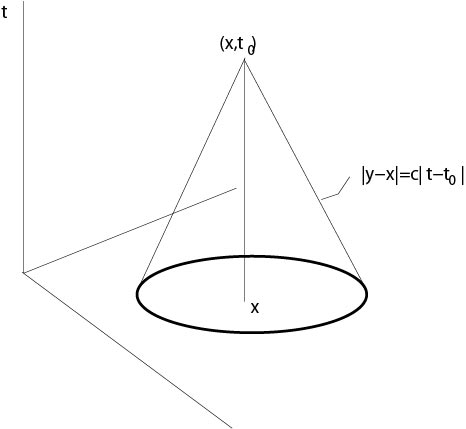4.2.1: Case n=3
( \newcommand{\kernel}{\mathrm{null}\,}\)
The Euler-Poisson-Darboux equation in this case is
$$(rM)_{rr}=c^{-2}(rM)_{tt}.\]
Thus
From the d'Alembert formula we get formally
The right hand side of the previous formula is well defined if the domain of dependence
Set
$$
F_0(r)=\left\{
\]
The function
Lemma.
Proof. From definition of
$$\lim_{r\to+0} F(r)=f(x),\ \ \ \lim_{r\to+0} G(r)=g(x).\]
Thus
Then,
$$F''(r)=\dfrac{1}{\omega_n}\int_{\partial B_1(0)}\ \sum_{i,j=1}^n f_{y_iy_j}(x+r\xi)\xi_i\xi_j\ dS_\xi.\]
Thus
$$F''(+0)=\dfrac{1}{\omega_n}\sum_{i,j=1}^n f_{y_iy_j}(x)\int_{\partial B_1(0)}\ n_in_j\ dS_\xi.\]
We recall that
The solution of the above initial value problem, where
Since
$$\int_{r-ct}^{ct-r}\ \xi G_0(\xi)\ d\xi=0.\]
Thus
see Figure 4.2.1.1.

Figure 4.2.1.1: Changed domain of integration
For fixed
Since for fixed
$$u(x,t)=\lim_{r\to 0} M_0(r,t),\]
it follows from d'Hospital's rule that
Theorem 4.2. Assume
Proof. Above we have shown that a
Corollary. From Poisson's formula we see that the domain of dependence for

Figure 4.2.1.2: Domain of dependence, case
Contributors and Attributions
Integrated by Justin Marshall.


